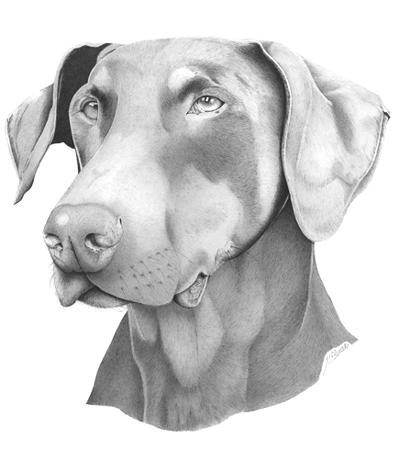Michael Benee wrote to ask:
“I have just finished my first dog portrait, and I mounted the cartridge paper onto a mounting board before I started. I notice that you use a heavy weight Mellotex paper is this so that there is no need for mounting, and is this how you supply your originals to your clients i.e.unmounted?”
You don’t say how you mounted your drawing paper to the stiffer support. I’d recommend vacuum mounting by your local framer, because other methods (spray adhesives, for example) may not be permanent or may bleed through to the surface with time.
I don’t ever mount my drawing paper mainly because I detest any “bounce” in the paper as I’m drawing. A smooth and hard surface beneath my Mellotex means that the mark I make is the mark as I intended it – not one that sinks into a soft surface that interferes with my control. If your paper is lightweight, change to a heavier weight and place it on a melamine or similarly hard surface, such as a drawing board. Even tabletop drawing boards usually possess such a surface.
Another reason why I don’t mount my paper is that most of my work is destined to be released as limited edition prints. That means it has to be scanned and, in my opinion, you can’t beat a laser drum scanner, which demands that the paper be sufficiently flexible to wrap around the scanner’s drum.
When (rarely these days) I present a commissioned original to my client it is always in its raw state – trimmed to a suitable size and displayed in a custom-made matboard folder. The folder protects the drawing and doubles as a presentation easel, further protecting the drawing from being handled.
Michael added:
“Please find enclosed a pic of my first attempt at drawing my dog, any comments would be welcomed with open arms”

For a first attempt (even for a tenth) this is admirable! Weimaraners suit graphite so well. The eyes are beautifully studied and executed and sufficient directional facial hair suggests the texture. My only criticisms are that the texture does not extend to the muzzle, which appears to be too smooth; that the dog overall is too tidy (it’s the out of place hairs, flecks of foam etc that add a sense of reality); and the nose has a highlight suggesting a shine, although Weimaraners have quite a dry, non-reflective nose.
Finally, just a personal preference, I would have feathered the bottom edge of the neck to suggest an unseen continuation.
That said, well done!